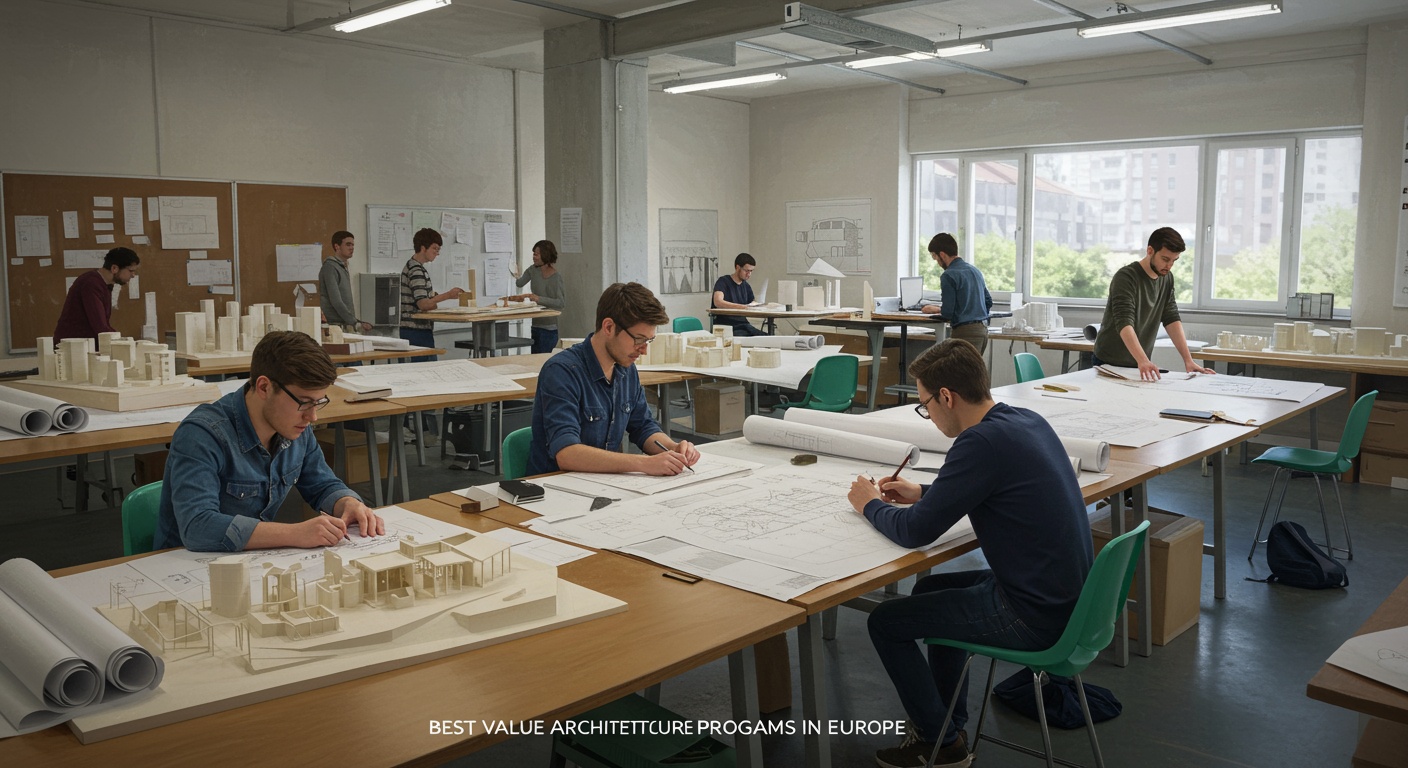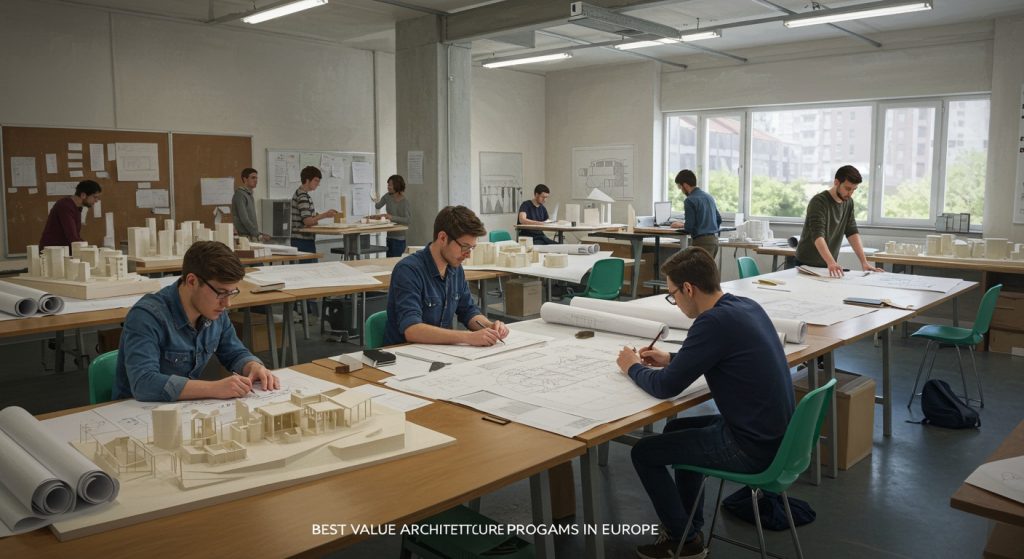Aspiring architects face a critical decision: securing a top-tier education without crippling debt. The European landscape offers a compelling solution, with institutions like TU Delft in the Netherlands and RWTH Aachen in Germany leading the charge in innovative, affordable architecture programs. We’ll navigate this terrain, focusing on programs integrating sustainable design principles and BIM technologies – crucial in today’s eco-conscious and digitally-driven construction industry. Discover how factors like tuition fees, living costs. Scholarship opportunities shape the true value proposition. Prepare to uncover the best pathways to launch your architectural career in Europe, balancing quality education with financial prudence.

Understanding “Value” in Architecture Education
When evaluating architecture programs, “value” extends beyond just tuition fees. It encompasses a combination of factors, including:
- Tuition Costs: The actual fees charged by the university per semester or academic year.
- Living Expenses: The cost of accommodation, food, transportation. Other daily necessities in the city or region where the university is located.
- Program Quality: The reputation of the architecture school, the expertise of the faculty, the curriculum’s relevance to current industry trends. The availability of resources like workshops, studios. Digital fabrication labs.
- Career Opportunities: The likelihood of securing internships and employment after graduation, influenced by the school’s connections with local and international firms, career services support. Alumni network.
- Scholarships and Funding: The availability of scholarships, grants. Other financial aid options to reduce the financial burden on students.
Therefore, a “best value” architecture program offers a strong educational foundation and promising career prospects at a relatively affordable cost.
Country-by-Country Breakdown: Affordable Architecture Education in Europe
Several European countries offer high-quality architecture programs at a fraction of the cost of programs in the United States or the United Kingdom. Here’s a look at some of the top contenders:
Germany
Germany’s public universities are renowned for their academic rigor and relatively low tuition fees. Most German universities charge only a semester fee (Semesterbeitrag), which covers administrative costs and student services, typically ranging from €150 to €300 per semester. But, living expenses in major cities like Munich or Berlin can be substantial.
Notable Universities:
- RWTH Aachen University: Known for its strong engineering and architecture programs, RWTH Aachen offers a diverse range of architecture specializations.
- Technical University of Munich (TUM): TUM consistently ranks among the top universities globally, boasting cutting-edge facilities and a focus on innovation.
- Bauhaus-Universität Weimar: Steeped in history, Bauhaus-Universität Weimar carries the legacy of the Bauhaus movement, emphasizing interdisciplinary collaboration and design experimentation.
Considerations: Many programs are taught in German, so proficiency in the language is often required. But, some universities offer international programs in English.
Italy
Italian universities offer a rich cultural context for studying architecture, with a focus on history, preservation. Urban design. Tuition fees vary depending on the university and the student’s income. Generally range from €900 to €4,000 per year.
Notable Universities:
- Politecnico di Milano: One of Italy’s leading technical universities, Politecnico di Milano offers a comprehensive architecture curriculum with a strong emphasis on research and innovation.
- Politecnico di Torino: Known for its engineering and architecture programs, Politecnico di Torino provides a practical, hands-on approach to architectural education.
- Università Iuav di Venezia: Located in the heart of Venice, Iuav offers a unique learning environment focused on urban planning, architectural design. The preservation of historic cities.
Considerations: Knowledge of Italian is beneficial, although some universities offer courses in English, particularly at the master’s level. The cost of living in cities like Milan and Venice can be relatively high.
France
French public universities offer affordable tuition fees, typically around €170 per year for Bachelor’s programs and €243 per year for Master’s programs. But, living expenses in Paris can be significant. Architecture programs in France often emphasize theoretical and historical aspects of the discipline.
Notable Universities:
- École Nationale Supérieure d’Architecture de Paris-Belleville: One of the most prestigious architecture schools in France, Paris-Belleville offers a rigorous curriculum and a strong focus on urban design.
- École Nationale Supérieure d’Architecture de Lyon: Known for its innovative approach to architectural education, Lyon emphasizes experimentation and critical thinking.
- École Nationale Supérieure d’Architecture de Marseille: Located in the vibrant city of Marseille, this school offers a unique perspective on Mediterranean architecture and urbanism.
Considerations: French language proficiency is generally required for admission. Some programs offer intensive language courses for international students.
Spain
Spanish universities offer a blend of historical and contemporary architectural perspectives. Tuition fees vary but are generally lower than in other Western European countries, ranging from €700 to €3,000 per year. The cost of living is also relatively affordable, especially in cities outside of Madrid and Barcelona.
Notable Universities:
- Universitat Politècnica de Catalunya (UPC), Barcelona: UPC is renowned for its architecture and engineering programs, offering a wide range of specializations and a strong focus on sustainable design.
- Universidad Politécnica de Madrid (UPM): UPM is one of Spain’s leading technical universities, with a strong emphasis on research and innovation in architecture.
- Universidad de Sevilla: Located in the historic city of Seville, this university offers a unique perspective on Andalusian architecture and urbanism.
Considerations: Spanish language proficiency is essential for most programs. But, some universities offer courses in English, especially at the master’s level.
Other Countries
Other European countries offering affordable architecture education include:
- Poland: Universities like the Warsaw University of Technology and the Cracow University of Technology offer programs in English at reasonable tuition rates.
- Czech Republic: The Czech Technical University in Prague is a well-regarded institution with affordable tuition fees.
- Portugal: Universities in Lisbon and Porto offer high-quality architecture programs at competitive prices.
Assessing Program Quality: Key Indicators
Beyond cost, evaluating the quality of an architecture program is crucial. Consider these factors:
- Accreditation: Ensure the program is accredited by recognized architectural accreditation bodies (e. G. , NAAB in the US; RIBA in the UK; EAAE in Europe). Accreditation signifies that the program meets certain standards of quality and prepares graduates for professional practice.
- Faculty Expertise: Research the faculty members’ backgrounds, publications. Professional experience. Look for professors who are actively involved in research, practice. Industry collaborations.
- Curriculum: Examine the curriculum to ensure it covers essential topics such as architectural design, history, theory, technology, sustainability. Professional practice. A well-rounded curriculum will equip you with the necessary skills and knowledge for a successful career in architecture.
- Studio Culture: A strong studio culture fosters collaboration, creativity. Critical thinking. Look for programs that emphasize hands-on learning, design critiques. Peer interaction.
- Resources and Facilities: Assess the availability of resources such as design studios, workshops, computer labs, digital fabrication equipment. Libraries. Access to these resources is essential for completing design projects and developing technical skills.
- Industry Connections: Inquire about the program’s connections with local and international architecture firms, internship opportunities. Alumni network. Strong industry connections can significantly enhance your career prospects.
Real-World Applications and Case Studies
Many architecture programs incorporate real-world projects and case studies into their curriculum. For example:
- Design-Build Projects: Students may participate in design-build projects, where they design and construct actual buildings or structures. This provides valuable hands-on experience and allows students to apply their knowledge in a practical setting.
- Community Engagement Projects: Some programs partner with local communities to address architectural and urban planning challenges. Students may work on projects such as designing affordable housing, revitalizing public spaces, or preserving historic buildings.
- International Workshops: International workshops offer students the opportunity to collaborate with students and faculty from other countries on design projects that address global issues.
For example, students at the Bauhaus-Universität Weimar have participated in numerous design-build projects, including the construction of sustainable housing prototypes. These projects provide students with valuable experience in all aspects of the design and construction process.
Scholarships and Funding Opportunities
Several scholarships and funding opportunities are available to international students pursuing architecture degrees in Europe:
- Government Scholarships: Many European governments offer scholarships to international students. These scholarships can cover tuition fees, living expenses, or both.
- University Scholarships: Universities often offer scholarships based on academic merit or financial need.
- External Funding Organizations: Organizations such as the Erasmus+ program and the Fulbright Program provide funding for international study.
It’s crucial to research and apply for scholarships early in the application process. Many scholarships have deadlines that are several months before the start of the academic year.
Navigating the Application Process
Applying to architecture programs in Europe can be a complex process. Here are some tips to help you navigate the application process:
- Research Program Requirements: Carefully review the admission requirements for each program you are interested in. This may include submitting transcripts, standardized test scores, portfolios. Letters of recommendation.
- Prepare a Strong Portfolio: Your portfolio is a crucial component of your application. It should showcase your design skills, creativity. Technical abilities. Include a variety of projects, such as drawings, models. Digital renderings.
- Write a Compelling Personal Statement: Your personal statement is an opportunity to explain your motivations for studying architecture and to highlight your relevant experiences and skills.
- Obtain Letters of Recommendation: Request letters of recommendation from professors or professionals who know you well and can speak to your abilities and potential.
- Meet Application Deadlines: Be sure to submit your application by the deadline. Late applications may not be considered.
By carefully researching programs, preparing a strong application. Seeking out financial aid opportunities, you can significantly increase your chances of being accepted into a top architecture program in Europe.
Conclusion
Choosing the right architecture program in Europe is a significant investment, not just financially. Also in your future. As highlighted, several institutions offer incredible value by balancing quality education with reasonable costs. Remember, “value” isn’t solely about tuition fees; consider the resources offered, the faculty’s expertise. The program’s alignment with your architectural aspirations. The road ahead involves thorough research and potentially, visits to shortlisted universities. Don’t underestimate the power of networking; connect with current students and alumni to gain firsthand insights. I recall a conversation with an alumnus from TU Delft who emphasized the importance of the studio culture, which significantly shaped their design approach. Finally, trust your gut feeling; the best value program is the one that resonates with your personal and professional goals. Your architectural journey starts now, so embrace the challenge and build your dream.
More Articles
Architectural Design Excellence in Italian Universities
Best Colleges for Architecture in the United Kingdom
France’s Finest: Advanced Engineering Studies
Affordable Engineering Colleges in India: A Value Proposition
FAQs
Okay, so ‘best value’ is subjective, right? What are we really talking about here?
Totally! ‘Best value’ for architecture programs means finding the sweet spot between tuition fees, cost of living. The quality of education you’re getting. It’s not just about the cheapest option. Where your money goes the furthest in terms of learning, experience. Future career prospects.
Which European countries are generally known for affordable architecture programs?
Good question! Germany, Italy. The Nordic countries (especially Norway and Finland, although living costs can be higher there) often have lower or even free tuition for international students at public universities. Poland and Czech Republic can also be quite budget-friendly.
Free tuition sounds amazing! Is there a catch?
Well, usually there’s something. Often, free tuition applies only to programs taught in the local language. So, if you don’t speak German, for example, you’ll likely need to enroll in a language course first. Also, even if tuition is free, you still need to budget for living expenses, which can vary wildly depending on the city.
What should I look for in an architecture program besides the price tag?
Excellent point! Think about the program’s focus. Does it align with your interests? Are they strong in sustainable design, urban planning, or historical preservation, for example? Also, check the faculty’s credentials, the studio facilities, internship opportunities. The program’s reputation within the architecture community.
How essential is accreditation? And who accredits architecture programs in Europe anyway?
Accreditation is pretty crucial. It’s like a quality stamp that says the program meets certain professional standards. In Europe, different countries have their own accreditation bodies. Make sure the program you’re considering is accredited by a recognized organization in that country, or ideally, by a pan-European body like the European Network for Accreditation of Engineering Education (ENAEE).
Living costs can vary so much. How do I get a realistic idea of what I’ll actually be spending?
Research, research, research! Numbeo is a great website for comparing the cost of living in different cities. Also, look for student forums or groups for the universities you’re interested in. Current students can give you the real scoop on everything from rent prices to grocery costs.
Are there scholarships available for international architecture students in Europe?
Definitely! It takes some digging. Scholarships are out there. Start by checking the university’s website for scholarships specifically for international students. You can also explore general scholarship databases like Erasmus+ or DAAD (for Germany). Don’t be afraid to apply for multiple scholarships – every little bit helps!



